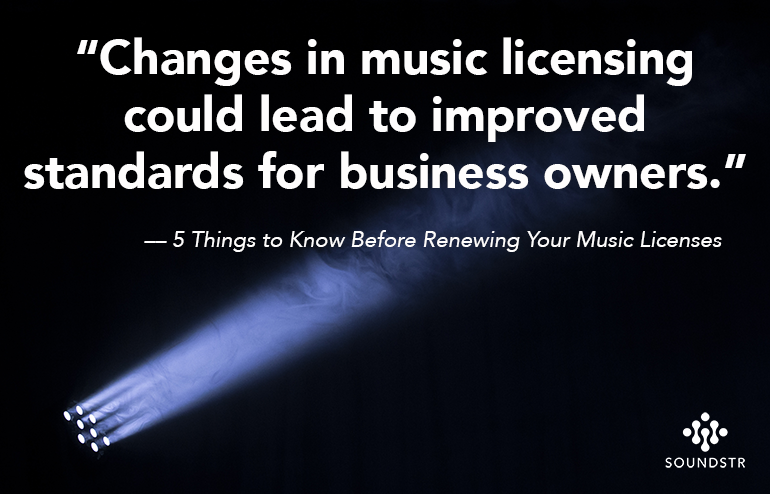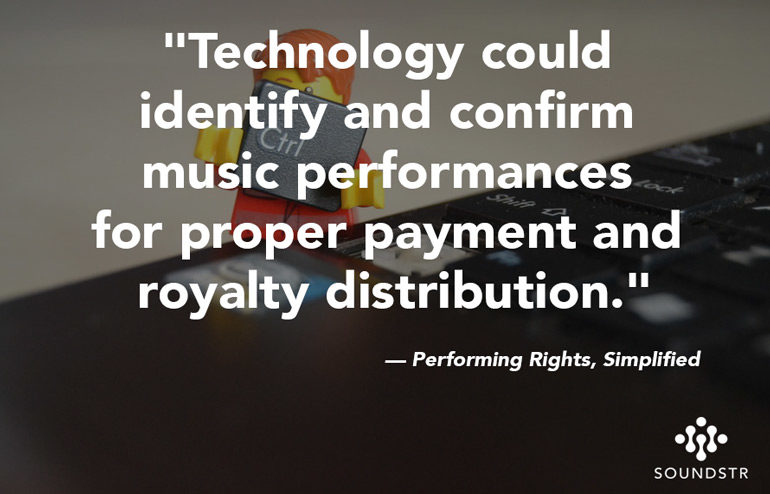With the New Year just around the corner, it’s likely time to renew your music licensing agreements. But this industry is under some major changes that could impact all businesses.
In June of 2016, the Department of Justice proposed changes to the Consent Decrees. These agreements govern how ASCAP and BMI, the two biggest US rights organizations, operate. (SESAC and GMR are not bound by these agreements. All four companies are known as Performing Rights Organizations, or “PROs”.) These changes would be the biggest update to the music licensing industry in 75 years. (Note: these changes and this post only relate to US-based PROs.)
Music licensing is a dense topic. Some businesses attempt to avoid paying license fees. But the threat of expensive fines is all too real. New technology is helping businesses negotiate fairer fees and more songwriters get paid. It’s time to take a second look at this industry.
1. Current Fee Structures (Bad for Businesses)
Before we jump into proposed changes, it’s important to know what you are already paying for. PROs collect money from music users so they can broadcast music and host performers. Real-world businesses, from concert venues to retail shops, are a part of the “general licensing” category. General licenses are “blanket licenses” which allow real-world music users to play any music within a PRO’s catalog (20 million+ songs). These licenses are determined based on capacity and how the music is being consumed (background music, interactive – band/DJ). Each PRO licenses different songs (although there is some overlap). Each PRO also has a different size catalog. The one thing license fees do not take into account is how much music your business plays from each catalog. It doesn’t make much sense to pay the same amount of money for each license when your business may not use as much music from one or more PRO.
With music tracking technology, a real-world business can now obtain transparency on their music use and negotiate fees based on actual music usage in their business. This is similar to how many households are cutting the cord with cable companies and only paying for the services and movies they want to watch. These blanket licenses are outdated and inefficient.
2. Current Royalty Structures (Bad for Songwriters)
What’s even worse about blanket licenses is who collects royalties from your fees. In the absence of data from real-world music use, the PROs use radio as the main proxy to distribute royalties. This means that if a songwriter performs or is broadcast in your business and is not on the radio, they likely do not earn money. Even worse, your fees are likely going to the big names on commercial radio. We at Soundstr did a case study to challenge this proxy. We sampled 3,000 songs in 12 businesses over 2 weeks. The result was that only 19% of songs played in businesses were also on commercial radio. That means roughly 81% of songwriters would not receive royalties from the use of their music. This is not fair.
3. Major Changes (More Mouths to Feed)
So now that you have some back story, let’s move onto changes. The biggest proposed change (actually interpretation of the Consent Decree) is the topic of “No Partial Withdraw.” Currently, music publishers use the PROs to issue public performance rights on behalf of their songwriters to all licensing categories (Radio, TV, Digital & General Licensing). Late last year, all three major publishers (Universal Music Group, Sony/ATV and Warner/Chappell), as well as some independent publishers, signed direct public performance licensing deals with Spotify, Pandora and other digital services. By cutting out the middlemen (PROs), these publishers make more money for their songwriters off direct deals. But, the Department of Justice is pushing to prevent cherry picking these direct deals. “No Partial Withdraw” means that the publishers either have to use the PROs for all four categories or none at all. If the publishers decide to go the “All-in” route, you will still only pay the four PROs (ASCAP, BMI, SESAC and GMR). If they choose the “All-out” option, your music licensing fees will change drastically. If one of the major publishers withdraw from the PROs, you will have another music license to obtain (ASCAP, BMI, SESAC and GMR + Sony, for example). If the tens of thousands of publishers withdraw, you will have many new licenses to pay (ASCAP, BMI, SESAC and GMR + Sony, Universal, Warner Chappell, Downtown, Kobalt, & thousands more). The new system could be complex and transparency around music usage would be essential.
4. Technology = Fairer Business Fees & More Songwriter Royalties
Licensing accounts for a large percentage of the entire annual music industry revenue. In fact, in 2014 the performing rights sector was ~31.5% of the size of the entire recorded music industry. (Note: performing rights are not calculated as a part of the recorded music industry.) Technology is looking to disrupt this sector, offering solutions for both businesses and songwriters. We at Soundstr also have some unique solutions rolling out this year. Using our services, businesses can now identify both recorded and live music usage. Having this data would allow a business to negotiate fairer license fees based on pro-rated music usage within their establishment. Either would eliminate overpaying for music or paying for music that was not used. Our mission at Soundstr is to help songwriters earn royalties they deserve for commercial use of their music. By identifying the music used in a business, the PROs can ditch the radio proxy altogether. The 81% of songwriters who were not played on commercial radio would receive compensation for their work. Fairer fees and more royalties sounds like a win-win!
5. The Future of Music Licensing (Better for Everyone!)
The basis of the performing rights industry is simple: when you do a job, you should receive compensation. This is the reason the performing rights industry exists in the first place. In 1847, French composer Ernest Bourget heard one of his works performed in a Parisian cafe, but was not compensated for his work. The lawsuit that followed led to the formation of SACEM, the world’s first PRO. The current system, unfortunately, is not that simple. But the future offers a bright outlook. With transparency around music usage data, new industry standards can be set. Any songwriter can receive compensation for commercial use of their music. Businesses will pay transparent fees based on their actual music use. Currently unlicensed businesses will now be able to afford licenses, pumping more money into the system. The current PRO model will need to be flexible, but the outcome will be a much more sustainable industry.
There are a lot of things business owners need to know when it comes to music licensing. This industry is in the midst of some big changes. Staying informed and knowing your options can make a big difference in your fee structure. Why pay for music you aren’t using? And don’t you want to know that your fees are making their way back to the correct songwriters? It’s easy to see the value that music provides to your business. But what about the value that business owners like you provide to the music industry? Technology may finally level the playing field.
Click below to learn more about how your business can use Soundstr to identify music usage and negotiate a fairer license. #MusicTransparency
Written by: Brian Penick
Copyediting: Eron Bucciarelli-Tieger, Claire Muenchen
Artwork: Lauren Osinksi
Image: Paul Green Photography




